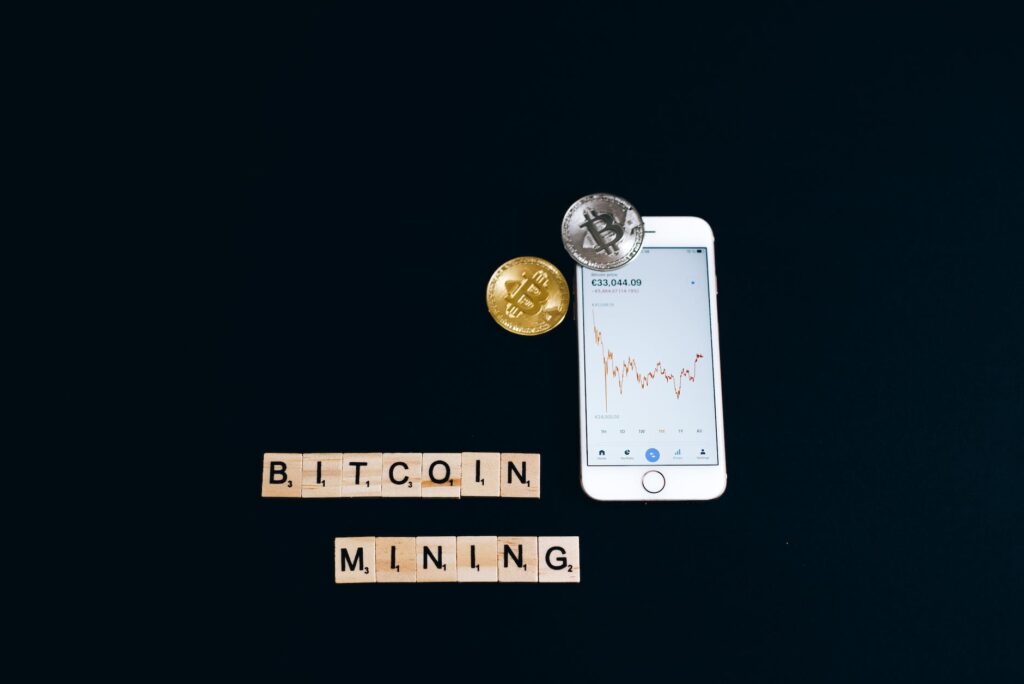Introduction to Bitcoin Mining
Bitcoin mining is a fundamental process that powers the Bitcoin network and enables the creation of new bitcoins. This section will provide an overview of what bitcoin mining entails and why it plays a crucial role in the world of cryptocurrencies.
What is Bitcoin Mining?
Bitcoin mining is the process of validating and verifying transactions on the Bitcoin network by solving complex mathematical problems. Miners use specialized hardware and software to compete with one another to solve these mathematical puzzles. Once a miner successfully solves a problem, they add a new block of transactions to the blockchain and are rewarded with a certain number of bitcoins.
The mining process serves two main purposes. Firstly, it ensures the security and integrity of the Bitcoin network by preventing double-spending and fraudulent transactions. Secondly, it creates new bitcoins and distributes them to miners, thus incentivizing their participation in the network.
Why is Bitcoin Mining Important?
Bitcoin mining is of paramount importance for several reasons. Firstly, it is essential for the security and stability of the Bitcoin network. Miners validate transactions and secure the network by ensuring that all transactions are legitimate and conform to the rules of the Bitcoin protocol.
Secondly, bitcoin mining is the primary method by which new bitcoins are introduced into circulation. As miners successfully solve mathematical problems and add new blocks to the blockchain, they are rewarded with bitcoins. This process controls the rate at which new bitcoins are created, effectively managing the supply and inflation of the cryptocurrency.
Furthermore, bitcoin mining allows individuals to participate in the decentralized nature of the Bitcoin network. Unlike traditional fiat currencies that are controlled by central banks, Bitcoin operates on a peer-to-peer network where no single entity has full control. Mining provides an opportunity for individuals to contribute to the network and be part of the consensus mechanism that governs the system.
In summary, bitcoin mining is a vital component of the Bitcoin ecosystem. It ensures the security and integrity of the network, creates new bitcoins, and allows individuals to participate in the decentralized nature of the cryptocurrency. Understanding the basics of how bitcoin mining works and its importance is crucial for anyone interested in the world of cryptocurrencies.
Understanding the Basics
To embark on the journey of bitcoin mining, it is essential to have a solid understanding of how the process works and the role miners play in the bitcoin network.
How Bitcoin Mining Works
Bitcoin mining is the process through which new bitcoins are created and transactions are verified on the blockchain. It involves solving complex mathematical problems using powerful computer hardware. These calculations serve two primary purposes: securing the network and adding new transactions to the blockchain.
Miners compete to solve these mathematical problems by attempting to find the correct solution through a process called proof-of-work. This involves repeatedly hashing the block’s data until a specific pattern, known as the target, is achieved. The miner who successfully finds the solution first is rewarded with newly minted bitcoins and transaction fees.
As more miners participate in the network, the difficulty of the mathematical problems increases to maintain a consistent rate of block creation. This ensures that new bitcoins are not generated too quickly and that the network remains secure. The difficulty level is adjusted approximately every two weeks based on the total computational power of the network. You can use a bitcoin mining calculator to estimate your potential earnings based on your mining setup.
The Role of Miners in the Bitcoin Network
Miners play a vital role in the bitcoin network by securing transactions and maintaining the integrity of the blockchain. When a transaction is initiated, it is broadcasted to the network and included in a pool of unconfirmed transactions, known as the mempool. Miners collect these transactions and group them into blocks.
Once a miner successfully solves the mathematical problem and adds a new block to the blockchain, the included transactions become permanently recorded. This process ensures that all transactions are transparent and cannot be altered retroactively.
In addition to verifying transactions, miners also contribute to the security of the network. As new blocks are added to the blockchain, they become more difficult to modify, making it extremely challenging for malicious actors to tamper with the transaction history.
It’s important to note that as the bitcoin network has grown, the computational power required for mining has significantly increased. Today, individual mining operations may find it difficult to compete with large-scale mining farms equipped with specialized bitcoin mining hardware. As a result, many miners opt to join mining pools, which allow them to combine their resources and increase their chances of earning rewards. To learn more about mining pools, check out our article on bitcoin mining pools.
Understanding how bitcoin mining works and the role miners play in the network is a crucial first step in starting your own mining operation. In the next section, we will explore the necessary steps to get started with bitcoin mining, including setting up a wallet, choosing the right mining hardware, and joining a mining pool.
Getting Started with Bitcoin Mining
To embark on the exciting journey of Bitcoin mining, there are a few essential steps you need to take. This section will guide you through setting up a Bitcoin wallet, choosing the right mining hardware, and joining a mining pool.
Setting Up a Bitcoin Wallet
Before you begin mining, it is crucial to have a secure and reliable Bitcoin wallet to store your earnings. A Bitcoin wallet is a digital wallet that allows you to send, receive, and store your Bitcoins securely. There are various types of wallets available, including hardware wallets, software wallets, and online wallets.
Hardware wallets, like the Ledger Nano S or Trezor, offer an extra layer of security by storing your private keys offline. Software wallets, such as Electrum or Exodus, are installed on your computer or mobile device and provide convenient access to your Bitcoins. Online wallets, like Coinbase or Blockchain.com, store your Bitcoins on the cloud and can be accessed from any device with an internet connection.
Choose a wallet that suits your needs in terms of security, accessibility, and user-friendliness. It’s important to research and select a reputable wallet provider that has a proven track record of security measures. For more information on Bitcoin wallets, you can refer to our article on bitcoin wallets.
Choosing the Right Mining Hardware
The next step is to choose the right mining hardware, as it plays a crucial role in your mining operation’s success. Bitcoin mining hardware is specially designed to solve complex mathematical algorithms and mine new Bitcoins.
When selecting mining hardware, there are a few factors to consider:
- Hash Rate: The hash rate refers to the speed at which a mining machine can solve mathematical problems. Higher hash rates result in more mining power, increasing the chances of earning Bitcoins.
- Energy Efficiency: Efficient mining hardware consumes less electricity, ensuring higher profitability and minimizing operational costs.
- Cost: Mining hardware comes in various price ranges. Consider your budget and calculate the return on investment (ROI) based on the hardware’s hashing power and energy consumption.
To get an estimate of the potential profitability of your mining operation, you can use a bitcoin mining calculator. These calculators take into account factors such as electricity costs, mining difficulty, and hardware specifications to provide an estimate of your potential earnings.
It’s important to stay up to date with the latest advancements in bitcoin mining hardware and choose a reputable manufacturer. Research different models, read user reviews, and compare specifications to make an informed decision.
Joining a Mining Pool
Bitcoin mining has become highly competitive, and mining alone may not always be profitable for individual miners. Joining a mining pool allows miners to combine their computing power and work together to mine Bitcoins more efficiently. When a pool successfully mines a new block, the rewards are distributed among the pool members based on their contributed hash power.
Joining a mining pool has several advantages, including:
- More consistent earnings: By pooling resources, miners receive more frequent payouts, providing a steady income stream.
- Reduced variance: Mining as part of a pool helps mitigate the fluctuations in mining rewards, providing a more predictable income.
- Access to better hardware: Mining pools often have access to more powerful mining hardware, increasing the chances of earning rewards.
There are several reputable bitcoin mining pools to choose from. Research different pools, consider factors such as pool fees, payout methods, and pool size before making a decision. Joining a mining pool can enhance your mining experience and increase your chances of earning Bitcoins.
By setting up a Bitcoin wallet, choosing the right mining hardware, and joining a mining pool, you’ll be well on your way to starting your Bitcoin mining journey. The next step is to explore mining software options and configure your mining setup to optimize performance and efficiency.
Mining Software and Configuration
Once you have set up your bitcoin mining hardware, the next step is to choose the right mining software and configure your mining setup for optimal performance and efficiency. In this section, we will explore the process of selecting mining software, configuring your mining setup, and optimizing performance.
Selecting Mining Software
Before you can start mining bitcoin, you need to select the appropriate mining software. The mining software acts as a bridge between your mining hardware and the bitcoin network. It allows you to connect to the network, participate in mining, and manage your mining operations.
When selecting mining software, consider factors such as compatibility with your mining hardware, ease of use, and the features it offers. Some popular mining software options include:
- CGMiner: An open-source ASIC/FPGA mining software that supports a variety of mining hardware.
- BFGMiner: Another open-source mining software that supports multiple hardware devices and offers advanced features for experienced miners.
- EasyMiner: A user-friendly mining software with a graphical interface, suitable for beginners.
- BitMinter: A Java-based mining software that provides a simple and intuitive interface for mining bitcoin.
Before making a final decision, it’s advisable to research and compare different mining software options to find the one that best suits your needs. You can also refer to our article on best bitcoin mining software for more information.
Configuring Your Mining Setup
Once you have chosen the mining software, the next step is to configure your mining setup. This involves setting up your mining hardware to work seamlessly with the selected mining software.
To configure your mining setup, follow these steps:
- Install the mining software on your computer or mining rig.
- Connect your mining hardware to your computer or rig using the appropriate cables and connections.
- Launch the mining software and enter the necessary configuration settings, such as the mining pool address and your mining account details.
- Adjust the mining software settings, such as the mining intensity or fan speed, based on your hardware capabilities and personal preferences.
The specific configuration steps may vary depending on the mining software you choose. It’s essential to refer to the software’s documentation or support resources for detailed instructions.
Optimizing Performance and Efficiency
To maximize your mining output and minimize energy consumption, it’s crucial to optimize the performance and efficiency of your mining setup. Here are some tips to help you achieve better results:
- Keep your mining hardware clean and regularly perform maintenance to prevent dust accumulation and overheating.
- Ensure that your mining hardware is running at the optimal temperature and fan speed for efficient operation. Refer to the manufacturer’s guidelines for recommended settings.
- Monitor your mining operation regularly to identify any issues or inefficiencies. Use monitoring software or tools provided by your mining software to track your progress.
- Consider joining a mining pool to increase your chances of earning bitcoin rewards. Mining pools allow miners to combine their resources and mine collectively, increasing the likelihood of finding blocks and receiving rewards. For more information, check out our article on bitcoin mining pools.
By selecting the right mining software, configuring your mining setup correctly, and optimizing performance and efficiency, you can enhance your bitcoin mining experience and increase your chances of success. Stay informed about the latest developments in bitcoin mining technology and continue to adapt your mining operations accordingly.
Managing Mining Operations
Once you have set up your bitcoin mining operation, it’s important to effectively manage and optimize your mining activities. This section will cover key aspects of managing your mining operations, including monitoring and tracking progress, dealing with challenges and troubleshooting, and scaling up your mining operation.
Monitoring and Tracking Progress
Monitoring and tracking the progress of your mining operations is essential for staying informed about the performance of your mining hardware and the overall efficiency of your setup. By regularly monitoring key metrics, you can make informed decisions and ensure that your mining operation remains profitable.
To effectively monitor your mining activities, consider the following:
-
Hashrate: Keep track of the hashrate produced by your mining equipment. This metric represents the speed at which your hardware can solve complex mathematical problems and earn bitcoin rewards. Monitoring your hashrate helps you identify any drops in performance and take necessary actions to optimize efficiency.
-
Mining Pool Statistics: If you are part of a mining pool, regularly check the statistics provided by the pool. This includes metrics such as the total hashrate of the pool, your individual hashrate contribution, and the rewards earned. These statistics can help you gauge your mining progress within the pool and compare your performance with other miners.
-
Bitcoin Mining Calculator: Utilize a bitcoin mining calculator to estimate your potential earnings based on your hashrate, electricity costs, and other relevant factors. This can help you set realistic expectations and assess the profitability of your mining operation. Here is an example of a bitcoin mining calculator.
Dealing with Challenges and Troubleshooting
As with any complex operation, challenges and issues may arise during your bitcoin mining journey. It is important to be prepared to tackle these challenges effectively:
-
Hardware Failures: In the event of hardware failures or malfunctions, it is crucial to have a backup plan in place. Consider keeping spare parts or backup mining equipment to minimize downtime and maintain continuity in your mining operations.
-
Network Connectivity: Unstable internet connections can disrupt your mining activities. Ensure reliable internet connectivity and consider backup options like redundant internet connections or backup power supplies to avoid interruptions.
-
Software Configuration: Occasionally, software issues may arise, leading to mining disruptions. Stay informed about the latest updates and releases for your mining software, and promptly address any software-related issues that may arise. Here is an example of a resource for selecting the best bitcoin mining software.
-
Bitcoin Mining Difficulty: Bitcoin mining difficulty is adjusted periodically to maintain a consistent block generation time. As mining difficulty increases, it becomes harder to mine bitcoin. Stay updated on changes in mining difficulty, as it can significantly impact your mining operations. Here is an example of a resource explaining bitcoin mining difficulty.
Scaling Up Your Mining Operation
As you gain experience and confidence in your mining activities, you may consider scaling up your mining operation to increase your potential earnings. Scaling up involves expanding your mining hardware and increasing your mining capacity.
When scaling up, consider the following:
-
Additional Mining Equipment: Evaluate the option of acquiring additional mining hardware to increase your hashrate and mining power. Research and select the most suitable bitcoin mining equipment that aligns with your budget and requirements.
-
Power and Cooling Infrastructure: Scaling up your mining operation may require additional power and cooling resources. Ensure that your infrastructure can handle the increased load and implement effective cooling measures to prevent overheating and hardware damage.
-
Financial Planning: Scaling up your mining operation entails additional costs, including hardware expenses, electricity costs, and maintenance. Conduct a thorough financial analysis to ensure that scaling up is financially viable in the long run.
By effectively managing your mining operations, monitoring progress, addressing challenges, and scaling up strategically, you can optimize your bitcoin mining activities and maximize your potential earnings in this dynamic and evolving industry.
The Future of Bitcoin Mining
As the world of cryptocurrencies continues to evolve, so does the practice of Bitcoin mining. In this section, we will explore the future of Bitcoin mining, including evolving mining technology, potential challenges and opportunities, and the importance of staying informed and adapting.
Evolving Mining Technology
Bitcoin mining technology has come a long way since its inception. Miners are constantly seeking more efficient and powerful hardware to improve their mining operations. The development of specialized bitcoin mining hardware has significantly increased the computational power, allowing for faster and more accurate mining processes.
In addition to hardware advancements, mining software has also seen significant improvements. Miners now have a wide range of options when it comes to selecting mining software, each with its own unique features and capabilities. These software solutions help miners optimize their operations, monitor their progress, and maximize their mining efficiency.
With the growth of cloud computing, some miners are also exploring the option of cloud bitcoin mining. This approach allows miners to rent computing power from remote data centers, eliminating the need for owning and maintaining physical mining equipment. Cloud mining offers convenience and scalability, but it’s important to carefully evaluate the associated costs and risks.
Potential Challenges and Opportunities
While the future of Bitcoin mining holds tremendous potential, it also presents its fair share of challenges and opportunities. One of the key challenges is the increasing bitcoin mining difficulty. As more miners join the network, the difficulty level adjusts to maintain a consistent rate of block creation. This means that miners need to continually upgrade their hardware and improve their operational efficiency to stay competitive.
Another challenge is the energy consumption associated with Bitcoin mining. As the network grows, the energy requirements for mining also increase. Miners are exploring ways to make their operations more environmentally friendly by utilizing renewable energy sources and adopting energy-efficient mining equipment.
Despite the challenges, there are also several opportunities for miners in the future. The potential for higher returns on investment, especially during periods of bullish cryptocurrency markets, continues to attract new participants to the mining ecosystem. Additionally, the mining community plays a vital role in the security and stability of the Bitcoin network, which in turn supports the overall growth and adoption of cryptocurrencies.
Staying Informed and Adapting
To thrive in the ever-changing landscape of Bitcoin mining, it is crucial for miners to stay informed and adapt to the latest developments. Keeping up with industry news, technological advancements, and regulatory changes is essential for making informed decisions.
Joining online communities, attending conferences, and participating in mining forums can provide valuable insights and networking opportunities. It is also important to regularly review and analyze mining performance, adjusting strategies and equipment as needed. Utilizing tools such as bitcoin mining calculators can help miners estimate their potential profits and make informed decisions.
Bitcoin mining is a dynamic and evolving field. By staying informed, embracing technological advancements, and adapting to the changing landscape, miners can position themselves for success in the future of Bitcoin mining.



